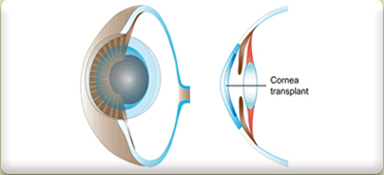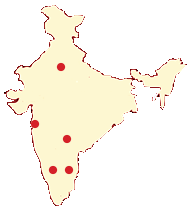Overview
What is the significance of the cornea ?
The cornea is the transparent front surface of the eye. It is an important optical structure through which rays of light enter the eye. Any damage or injury to this delicate structure can lead to permanent loss of corneal transparency or in other words cause clouding and opacification.

What is ‘Corneal Transplantation’?
Corneal transplantation / keratoplasty/ corneal grafting is the surgical procedure that restores sight in patients suffering from corneal blindness. In this surgical procedure , the diseased opaque cornea is replaced by a clear healthy donor corneal tissue which restores sight by allowing the light rays to enter the eye through transplanted clear cornea.
This procedure of corneal grafting is possible only on the availability of donor cornea by process of eye donation. By donating eyes after death a human being can restore sight to a blind person. This gift of sight is invaluable for these visually handicapped persons.
Who can not donate eyes?
- Those with infectious diseases like Syphillis, AIDS, Septicaemia.
- Death due to Carcinoma or Cancer.
- Death due to unknown cause.
- Eyes with Corneal Disease.
Who can donate eyes?
Eye donation is possible only after death. Any person of any age, sex, caste or religion, people who wear glasses or have undergone an eye surgery can donate. People of any age group can pledge to donate his/ her eyes after death. Even if one has not pledged their eyes themselves, the relatives can give their consent for the donation of the eyes of the deceased.
Risk
The signs that the transplant is being rejected include a combination of the following : -
- pain
- red eye
- blurred vision
- sensitivity to light.
On the whole, corneal transplants for corneal dystrophies have a very low rate of rejection. If you ever feel that there is a problem with your transplant you must seek medical advice immediately at your nearest eye department.
Benefits of corneal transplants
The success rate of corneal transplants as a treatment for corneal dystrophies is very high. For a graft to be considered, the dystrophy will already have caused serious sight loss and a corneal transplant offers a good opportunity to return to having good vision.After the operation
You may have to stay in hospital for a day or two, but some people are able to go home on the day of the operation. The operated eye may be covered with an eye pad and a plastic eye shield, which would be removed the day after the operation. If you feel any discomfort or pain, do ask for pain relief.When the pad is removed you may find that your vision will be blurred. This is quite normal. Your eye may also be a bit watery and sensitive to light. You will be given eye drops to use, some of which you may require for months and years. The drops help to reduce the likelihood that your body will reject the transplant. It can take more than a year for the transplant to heal completely.
A few months after the operation, it may be necessary to have either spectacles or contact lenses to obtain the best possible vision from the transplant. However, your vision may fluctuate as the transplant heals.
For more information, medical assessment and medical quote
as email attachment to
Email : - info@wecareindia.com
Contact Center Tel. (+91) 9029304141 (10 am. To 8 pm. IST)
(Only for international patients seeking treatment in India)










